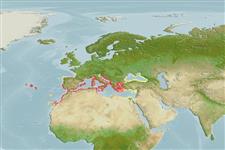Preferred temperature (Ref.
123201): 17.1 - 21.2, mean 18.9 °C (based on 449 cells).
Phylogenetic diversity index (Ref.
82804): PD
50 = 0.5000 [Uniqueness, from 0.5 = low to 2.0 = high].
Bayesian length-weight: a=0.01072 (0.00572 - 0.02007), b=3.02 (2.86 - 3.18), in cm total length, based on LWR estimates for this species & Genus-body shape (Ref.
93245).
مستوى غذائي (Ref.
69278): 2.7 ±0.1 se; based on diet studies.
المرونه (Ref.
120179): عالي, الحد الزمني الأدني لتضاعف عدد أفراد المجتمع أقل من 15 شهر (Preliminary K or Fecundity.).
Fishing Vulnerability (Ref.
59153): Low vulnerability (10 of 100).
Nutrients (Ref.
124155): Calcium = 333 [153, 795] mg/100g; Iron = 1.81 [1.03, 3.51] mg/100g; Protein = 18.7 [17.5, 19.8] %; Omega3 = 0.293 [0.148, 0.581] g/100g; Selenium = 9.43 [4.47, 22.49] μg/100g; VitaminA = 23.5 [6.6, 83.7] μg/100g; Zinc = 1.72 [1.10, 2.68] mg/100g (wet weight);
